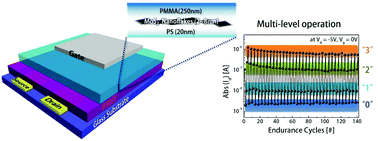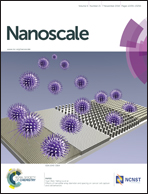Stable charge storing in two-dimensional MoS2 nanoflake floating gates for multilevel organic flash memory†
Abstract
In this study, we investigated chemically exfoliated two-dimensional (2-D) nanoflakes of molybdenum disulfide (MoS2) as charge-storing elements for use in organic multilevel memory devices (of the printed/flexible non-volatile type) based on organic field-effect transistors (OFETs) containing poly(3-hexylthiophene) (P3HT). The metallic MoS2 nanoflakes were exfoliated in 2-methoxyethanol by the lithium intercalation method and were deposited as nano-floating gates between polystyrene and poly(methyl methacrylate), used as bilayered gate dielectrics, by a simple spin-coating and low temperature (<150 °C) process. In the developed OFET memory devices, electrons could be trapped/detrapped in the MoS2 nano-floating gates by modulating the charge carrier density in the active channel through gate bias control. Optimal memory characteristics were achieved by controlling the thickness and concentration of few-layered MoS2 nanoflakes, and the best device showed reliable non-volatile memory properties: a sufficient memory window of ∼23 V, programming–reading–erasing cycling endurance of >102 times, and most importantly, quasi-permanent charge-storing characteristics, i.e., a very long retention time (longer than the technological requirement of commercial memory devices (>10 years)). In addition, we successfully developed multilevel memory cells (2 bits per cell) by controlling the gate bias magnitude.


 Please wait while we load your content...
Please wait while we load your content...